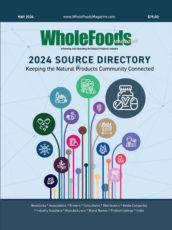
Quicklinks
WholeFoods Magazine
Dietary Supplement Categories Trending in 2023

Like pretty much everyone else in the dietary supplement industry, I would like to be able to look into a crystal ball and predict the top product categories of interest for the upcoming year. Not surprisingly, I don’t have a crystal ball. That being said, I do have 43 years of experience in the industry, and I read numerous reports about industry trends in order to stay as current as possible and gain a sense of the direction things are going. Consequently, I decided to focus on three dietary supplement categories that I believe will be trending in 2023. These include bone and joint health, hydration, and eye health.
So, since it makes sense to look at other nutraceuticals besides glucosamine and chondroitin for joint health, not to mention ingredients for bone health, for which ingredients should you be looking at? Clearly there are many to choose from, but I’m going to review just two of them today—starting with vitamin K2 for bone health.
The vitamin-K dependent proteins Osteocalcin and matrix Gla protein (MGP) are found in bones. Osteocalcin is needed for bone mineralization, while MGP is found in bone, cartilage, and soft tissue. Studies have shown that MGP prevents soft tissue and cartilage calcification, while promoting normal bone growth and development (4-6). In terms of dosage, 244 healthy postmenopausal women received a daily dose of 180 mcg of vitamin K2 as MK-7, or a placebo as part of a 3-year study (7). The results were that, compared to placebo, vitamin K2 significantly decreased the age-related decline in bone mineral content and bone mineral density. Vitamin K2 also favorably affected bone strength and significantly decreased the loss in vertebral height.
A double-blind, randomized, parallel-group clinical trial (8) was carried out over a period of six months to evaluate the efficacy of a water extract of cucumber fruit against glucosamine-chondroitin (GC) in managing moderate osteoarthritis of the knee. A total of 122 patients aged between 40 and 75 years participated The GC group received 2,700 mg of GC daily and the cucumber group, received 20-mg daily of the cucumber extract. The results were that, in the cucumber group, the pain score (WOMAC) was reduced by 70.39%, compared to only 33.7% in the GC group. No adverse effect was reported during the trial period, and the researchers indicated that the cucumber extract was significantly more effective than glucosamine-chondroitin in reducing pain related to moderate knee osteoarthritis as well as improving physical function.
Originally, the popularity of eye health products was driven to a large extend by the AREDS studies, which examined the effects of nutraceuticals on slowing the progression of macular degeneration. Formulas based on the AREDS studies are prevalent and have existed for 20 years. Likewise, lutein products, which provide protection against the harmful effects of blue light from digital devices, have also become relatively common. Although both types of products are solidly supported by human clinical studies, the challenge (once again) is how to differentiate an eye health product so it’s not just “me too.” I suggest considering the other carotenoids for eye health: capsanthin, zeaxanthin, and cryptoxanthin.
A special fraction of Capsicum annum L fruits (CapsiClear) provides 50% to 80% capsanthin, 5% to 15% zeaxanthin, and 1% to 5% cryptoxanthin. When tested in a 12-week, placebo-controlled human clinical study (12) at a dose of 40 mg/day, results showed that cumulative macular pigment optical density (MPOD)—reflecting the protective capacity of the carotenoids against blue light damage—increased at four weeks with this carotenoid combination. Furthermore, there were with additional increases at eight and 12 weeks when compared to the placebo, and photo stress also significantly improved—this is a measure a measure of how long it takes for visual acuity to be restored after the retina is overloaded with light, such as what might occur from oncoming headlights. Another improvement demonstrated was the ability to read under different cases of blue and white light exposure.
Bone and joint health products
Reportedly (1), data from SPINS (Chicago) indicate that the sales of supplement ingredients related to joint health decreased by 2.3% during the 52 weeks ending December 26, 2021. Much of this decrease may be due to the declining popularity of glucosamine and chondroitin, the original superstars of the joint category. Nevertheless, trends are now suggesting a renaissance for the joint health market. In fact, the overall global bone and joint health supplements market is estimated to be $11.7 billion in 2022 and to reach $17.6 billion by 2027, with a CAGR of 8.5% (2).Then, when you consider that 65-and-older population (primary users of bone and joint health products) grew by over a third (34.2% or 13,787,044) during the past decade, and by 3.2% (1,688,924) from 2018 to 2019 (3), indications are that this product category is on a positive trajectory for growth.So, since it makes sense to look at other nutraceuticals besides glucosamine and chondroitin for joint health, not to mention ingredients for bone health, for which ingredients should you be looking at? Clearly there are many to choose from, but I’m going to review just two of them today—starting with vitamin K2 for bone health.
Vitamin K2
Calcium and vitamin D products are the principal nutraceuticals for bone health, and rightfully so. Unfortunately, every other brand has a calcium and vitamin D product, so which nutraceutical can help a bone-health product to stand out in the crowd? In my opinion, vitamin K2 as menquinone-7 or MK7 is a very good option.The vitamin-K dependent proteins Osteocalcin and matrix Gla protein (MGP) are found in bones. Osteocalcin is needed for bone mineralization, while MGP is found in bone, cartilage, and soft tissue. Studies have shown that MGP prevents soft tissue and cartilage calcification, while promoting normal bone growth and development (4-6). In terms of dosage, 244 healthy postmenopausal women received a daily dose of 180 mcg of vitamin K2 as MK-7, or a placebo as part of a 3-year study (7). The results were that, compared to placebo, vitamin K2 significantly decreased the age-related decline in bone mineral content and bone mineral density. Vitamin K2 also favorably affected bone strength and significantly decreased the loss in vertebral height.
Cucumber extract
Glucosamine and chondroitin’s decline in popularity may, in part, be due to the fact that people want to take less pills, not more—and the glucosamine/chondroitin combination require at least four capsules daily to obtain a clinically relevant dose. One option requiring a substantially smaller dose is a relatively new cucumber-based extract (Q-Actin).A double-blind, randomized, parallel-group clinical trial (8) was carried out over a period of six months to evaluate the efficacy of a water extract of cucumber fruit against glucosamine-chondroitin (GC) in managing moderate osteoarthritis of the knee. A total of 122 patients aged between 40 and 75 years participated The GC group received 2,700 mg of GC daily and the cucumber group, received 20-mg daily of the cucumber extract. The results were that, in the cucumber group, the pain score (WOMAC) was reduced by 70.39%, compared to only 33.7% in the GC group. No adverse effect was reported during the trial period, and the researchers indicated that the cucumber extract was significantly more effective than glucosamine-chondroitin in reducing pain related to moderate knee osteoarthritis as well as improving physical function.
Hydration products
Completely different from the last category is hydration products, whose market size is expected to increase by $231.39 million at a CAGR of almost 7% by 2025 (9). Of course, the prominent nutraceuticals in this category are electrolytes. As with the previous category, however, hydration products with electrolytes are a dime a dozen (metaphorically speaking). To stand out, consider the use of multiple transportable carbohydrates.Multiple transportable carbohydrates
Multiple transportable carbohydrates are a mix of glucose and fructose, or maltodextrin and fructose, in a ratio of roughly 2:1. This combination of carbohydrates use different intestinal transporters for absorption. The result is up to 65% higher exogenous carbohydrate oxidation rates of multiple transportable carbohydrates during exercise compared with a single carbohydrate (e.g., glucose only) in a study (10). Not only did this increase in carbohydrate oxidation demonstrate an accompanying increase in energy/endurance, but it also demonstrated an increase in fluid delivery and improved oxidation efficiency. This means better hydration. Research (11) also demonstrated reduced fatigue and improved exercise performance with multiple transportable carbohydrates compared with a single carbohydrate.Eye health
Globally, the eye health supplements market is expected to achieve a CAGR of 6.25% during 2022-2027. As with bone and joint health, this category has many product users among the baby-boomer population; but prevalence of digital device use has also led to an increase in eye health product use by younger generations.Originally, the popularity of eye health products was driven to a large extend by the AREDS studies, which examined the effects of nutraceuticals on slowing the progression of macular degeneration. Formulas based on the AREDS studies are prevalent and have existed for 20 years. Likewise, lutein products, which provide protection against the harmful effects of blue light from digital devices, have also become relatively common. Although both types of products are solidly supported by human clinical studies, the challenge (once again) is how to differentiate an eye health product so it’s not just “me too.” I suggest considering the other carotenoids for eye health: capsanthin, zeaxanthin, and cryptoxanthin.
A special fraction of Capsicum annum L fruits (CapsiClear) provides 50% to 80% capsanthin, 5% to 15% zeaxanthin, and 1% to 5% cryptoxanthin. When tested in a 12-week, placebo-controlled human clinical study (12) at a dose of 40 mg/day, results showed that cumulative macular pigment optical density (MPOD)—reflecting the protective capacity of the carotenoids against blue light damage—increased at four weeks with this carotenoid combination. Furthermore, there were with additional increases at eight and 12 weeks when compared to the placebo, and photo stress also significantly improved—this is a measure a measure of how long it takes for visual acuity to be restored after the retina is overloaded with light, such as what might occur from oncoming headlights. Another improvement demonstrated was the ability to read under different cases of blue and white light exposure.
Conclusion
Lacking a crystal ball, it isn’t possible to provide definitive predictions for 2023. Still, the data certainly suggests that the supplement categories of bone and joint health, hydration, and eye health are growing. Therefore, if you’re a brand owner, you may want to consider developing new products, or upgrading your existing products to include the nutraceuticals discussed in this article—and if you’re a retailer, you may want to consider offering these products to your customers.References
- Reilly MK. Joint health supplements are ready to rebound. Nutritional Outlook. April 22, 2022; 25(3)
- Research and Markets. Bone & Joint Supplement Marke to Reach $17.6 Billion by 2027. Jul 05, 2022. Retrieved July 5, 2022 from https://www.prnewswire.com/news-releases/bone--joint-supplement-market-to-reach-17-6-billion-by-2027--301580445.html.
- 65 and Older Population Grows Rapidly as Baby Boomers Age. Press Release Number CB20-99. U.S. Census Bureau. June 25, 2020. Retrieved September 27, 2022 from https://www.census.gov/newsroom/press-releases/2020/65-older-population-grows.html.
- Shearer MJ. The roles of vitamins D and K in bone health and osteoporosis prevention. Proc Nutr Soc 1997;56(3):915-937.
- Booth SL. Skeletal functions of vitamin K-dependent proteins: not just for clotting anymore. Nutr Rev 1997;55(7):282-284.
- Suttie JW. Vitamin K. In: Shils ME, Shike M, Ross AC, Caballero B, Cousins RJ, eds. Modern Nutrition in Health and Disease. 10th ed. Baltimore: Lippincott Williams & Wilkins; 2006:412-425.
- Knapen MH, Drummen NE, Smit E, Vermeer C, Theuwissen E. Three-year low-dose menaquinone-7 supplementation helps decrease bone loss in healthy postmenopausal women. Osteoporos Int. 2013 Sep;24(9):2499-507.
- Nash RJ, Azantsa BKG, Sharp H, Shanmugham V. Effectiveness of Cucumis sativus extract versus glucosamine-chondroitin in the management of moderate osteoarthritis: a randomized controlled trial. Clinical Interventions in Aging 2018:13 2119–2126.
- Technavio. Hydration Products Market to Record $ 231.39 Mn Growth between 2021-2025 | Market Share, Trends, Drivers, and Opportunity Assessment | Technavio. Oct. 01, 2021. Retrieved July 5, 2022 from https://www.prnewswire.com/news-releases/hydration-products-market-to-record--231-39-mn-growth-between-2021-2025--market-share-trends-drivers-and-opportunity-assessment--technavio-301389303.html
- Jeukendrup AE. Multiple transportable Carbohydrates and their benefits. Sports Science Exchange. 2013;26(108): 1-5.
- Rowlands DS, Thornburn MS, Thorp RM, et al. Effect of graded fructose coingestion with maltodextrin on exogenous 14C-fructose and 13C-glucose oxidation efficiency and high-intensity cycling performance. J Appl Physiol. 2008; 104: 1709-1719.
- Determining the Effect of 12-weeks of Oral Capsanthin Supplementation on Body Weight, Lipid Profile, Liver Health, and Eye/Macular Health in Overweight Subjects. Study conducted by Dr. Brian et al at University of North Texas and sponsored by Unibar Corporation, USA.








